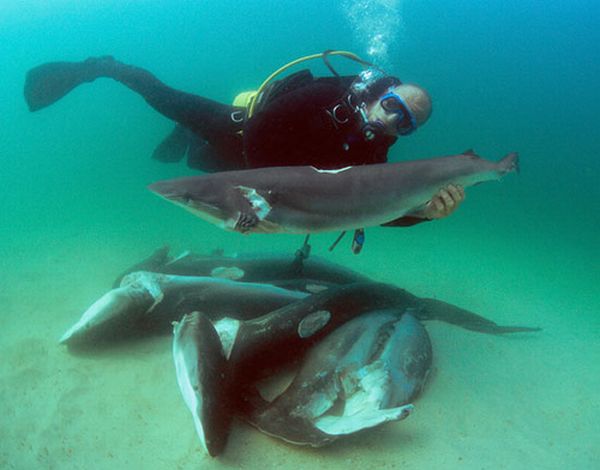Today is one of those days when I become Lindsey the shark-blogger. I am also being incredibly lazy and must admit that my inspiration to talk about sharks again came from a post on Matador. Actually, I'm incredibly lazy squared because I'm just going to share the entire article with you sans any kind of originally on my part.
7 reasons to ban shark finning
by Mary Pfaffko
 |
| Diver finds dead sharks that died a slow, painful death after being discarded off a finning boat. |
Fins are sliced off of sharks while their live bodies are tossed back into the ocean like trash. Here are 7 reasons why this practice should be banned.
1. Our most ancient species are endangered.
Sharks have existed since before the dinosaurs and pre-date humans by hundreds of millions of years. Once kings of natural selection, sharks are now facing extinction due to finning. Shark populations are extremely vulnerable because they take up to 20 years to reach sexual maturity and produce few young. The current demand for fins makes it impossible to restore populations to previous levels.Since 1972, the number of Blacktip, Tiger, Bull, Dusky, and Smooth Hammerhead sharks has fallen by over 90%. Already, 18-20 species of sharks are listed as endangered by theInternational Union for the Conservation of Nature (IUCN).2. The soup isn’t that good anyway.
No one is asking people to stop eating delicious soups, and shark fin soup is certainly not one of them. Shark fins are tasteless – fins are full of cartilage, which simply serves as a thickening agent.The soup has been served for centuries by Chinese at special occasions such as weddings so the hosts can impress their friends with excess wealth, since it can cost up to $100 per bowl. For the most part, the limited number of wealthy Chinese meant that the practice was sustainable, but the rapid growth in the Chinese economy since 1985 is directly correlated with the recent sharp decrease in shark populations.3. Changing shark populations destabilizes marine ecosystems.
Changes in shark populations alter the ecological dynamics within the entire ocean because sharks are apex predators and play a major role as ecological stabilizers.The domino effect: decimated Blacktip and Tiger Shark populations along the east coast of the US led to decreased shellfish populations, which led to decreased water quality since shellfish filter water. Another domino effect: fewer sharks increase octopus populations, which decrease lobster populations. At this rate, the oceanic ecosystem that has evolved over millions and millions of years would collapse.A recent study by the Monterey Bay Aquarium found that more than 75% of people surveyed support a shark finning ban.4. This isn’t just in Asia.
Outside of Asia, California is the largest market for fins. The Shark Finning Prohibition Act of 2000 prohibits the possession of fins without the corresponding carcass in U.S. waters but does not prohibit the importing or distribution of fins, so some of the fins that are legally imported through Los Angeles and San Diego are actually illegally obtained in U.S. waters.California Assembly Members Fong and Huffman have introduced Assembly Bill 376, a bill to ban the possession, sale, trade, and distribution of shark fins in California. Washington, Hawaii, and the Northern Mariana Islands have already passed a similar law and Oregon and Guam are considering it.5. Finning cashes in on cruelty.
Now that we’ve overfished the Bluefin Tuna, industry has turned to the sharks to cash in. Fins are worth up to $600 per pound. What happens when we overfish all of the sharks?6. It’s a wasteful practice.
Usually, only the fin is saved while the rest of the shark’s body is chucked overboard. Shark meat isn’t popular because of the high ammonia content, meaning that the carcass must move quickly from sea to table with the utmost care to prevent health hazards to the consumer. Shark meat isn’t valuable enough for fishermen to carefully store the huge carcasses on their ships.7. Longlining is killing more than sharks.
A “curtain of death” sweeps through the ocean, catching anything that goes for the bait. These “longlines” are meant to catch tuna and swordfish, but they actually catch anything that takes its bait, including endangered sharks, leatherback and loggerhead turtles, and seabirds (such as albatross). Over 25% of the longline catch is chucked back into the sea, usually left for dead.In most areas, longlining is perfectly legal and practiced routinely.Ban Shark Finning Worldwide
A recent study by the Monterey Bay Aquarium found that more than 75% of people surveyed support a shark finning ban. On the other side of the world, China’s most powerful television station, CCTV, has donated $70 million in time to air informative commercials about finning. The NBA’s most famous Chinese basketball player, Yao Ming, is plastered on San Francisco’s MUNI buses as part of WildAid’s campaign to end shark finning.What you can do
On June 10, 2011, the National Resources Defense Council (NRDC) will be holding its annual Splash Ball in San Francisco, CA. The theme of this year’s ball is Shindig for Sharks to raise awareness about the devastating impact finning on shark populations and the planet. For more information or to buy tickets to the Splash Ball ($95 per ticket), visit theSplash Ball Eventbrite site.In addition to supporting state bans, visit Stop Shark Finning for ideas about other actions you can take.
have you seen the cove?
ReplyDeleteno! I need to... it is sitting in my Netflix instant queue...
ReplyDelete